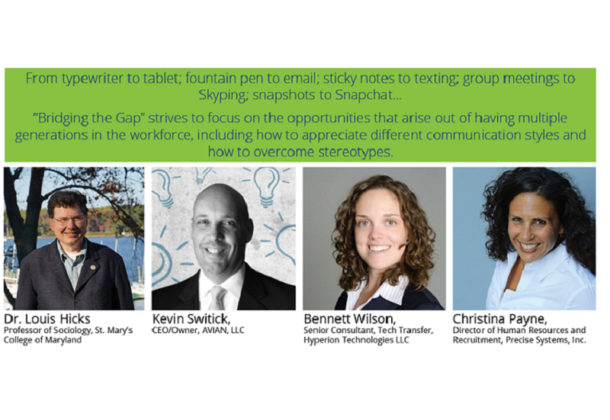Bridging the Gap in a Multigenerational Workforce

Millennials have surpassed Gen X-ers as the largest generation in the US workforce, according to the Pew Research Center. This information has raised questions and concerns for older generations about communication styles, values, and structure. These concerns and questions were at the center of a panel discussion held by The Patuxent Partnership, in collaboration with Next Gen Professionals and AVIAN LLC.
Dr. Louis Hicks, Professor of Sociology at St. Mary’s College of Maryland, led the discussion with an academic overview of generations in the workforce. Panelists included Kevin Switick, Chief Executive Officer, AVIAN LLC; Bennett Wilson, Senior Consultant, Tech Transfer, Hyperion Technologies LLC; and Christina Payne, Director of Human Resources and Recruitment, Precise Systems Inc.
Dr. Hicks looked at how sociologists define a generation, saying that generations can be defined by the following four criteria:
- A bunch of people born in a time period, usually roughly the length of human fertility and reproduction (20 or so years)
- Generations are connected to the idea of stages of the life course (childhood, young adult, mature adult, retiree, etc.)
- Connected to large scale events (World War II, 9/11)
- Connected to often-imaginary characteristics
Equipped with this knowledge, sociologists have summed up the classic American generations as:
- Greatest Generation, 1901-1924
- Silent Generation, 1925-1945
- Baby Boomers, 1946 -1964
- Gen X, 1965-1984
- Gen Y (Millennials), 1985-2000
- Gen Z, 2001-present up to age 15
It’s no secret that there can be tension between co-workers from different generations, stemming from differences in three key areas: culture, structure, and technology, Hicks said.
Culture can be thought of as things such as memories, vocabulary, dress, values, ideas, or jokes. Vivid memories for Millennials might include 9/11 or the election of President Obama, while memories for Baby Boomers could include the Cuban Missile Crisis or President Kennedy’s assassination. These memories shape each generation and give them varying outlooks for the future.
Structure includes hierarchy, relationships, and boundaries, three areas that most generations have worked tirelessly to climb, form, and set. Millennials can often be looked at as wanting to avoid or go around hierarchy. In the eyes of other generations Millennials are not working to climb the corporate ladder but rather start off in a position closer to the top. This can be attributed to the great success stories that Millennials grew up with, whether it is Facebook, Twitter, or Instagram. The twentysomething billionaires like Mark Zukerberg, Kevin Systrom, or Mike Krieger have upped the ante for what young people expect out of life – and their careers, according to Business insider. Boomers and Gen X are more likely to get down and dirty, working their way up from the bottom. But as one participant pointed out, some Boomers are not always “buying what you are selling,” referring to individuals who have worked through a long and hard career to not always be rewarded on the other side.
Technology is often a large obstacle for each generation. Millennials have a need, and sometimes addiction, to have their phones with them at all times. Text messages are preferred, checked rapidly and are expected to be replied to at the same speed. Boomers and Gen X aren’t on the same page. Boomers would rather talk on the phone, instead of text, and Gen X is more likely to email, but not at the snap of a finger. When it comes down to it, Millennials are the Connected Generation, they look for the latest technologies like Slack, Google Apps, or Trello to improve their communication channels, allowing them to be connected 24/7.
So, what makes your generation unique? Hicks shared an interesting graphic from the Pew Research Center that showed the top five responses to that exact question. Millennials believe that their characteristics include: technology use, music/pop culture, liberal/tolerant, smarter and clothes. Gen X responded with: technology use, work ethic, conservative/traditional, smarter and respectful. Boomers said: work ethic, respectful, values/morals, “Baby Boomers” and smarter. Lastly, the Silent Generation thought: WWII, Depression, smarter, honest, work ethic and values/morals were their characteristics.
Mr. Hicks jokingly pointed out that it was interesting how each generation thought they were smarter than the other.
To close the discussion, Mr. Switick told a story that summed up the conversation.
“I was once at a dinner with a bunch of big name CEOs, people from huge companies. The CEO of AT&T was asked, ‘How do you manage work/life balance in a job like yours?’ His answer was simple. He said, ‘You can have work/life balance but you’ll never have my job.’” A concept younger generations have a hard time grasping and accepting.
As Hicks pointed out, generations are often connected to imaginary characteristics. Bridging the gap for co-workers to work better or more efficiently cannot be answered by any individual. The key can often be found in reaching that middle ground of sufficient variety but still being able to work together.
About The Patuxent Partnership
The Patuxent Partnership works with government, industry, and academia on initiatives in science and technology, hosts programs of interest to NAVAIR and the broader DoD community, and supports workforce development including education initiatives and professional development. Call 301-866-1739.
Follow TPP on Facebook and Twitter.
To learn more about The Patuxent Partnership and its programs, visit its Leader member page.























